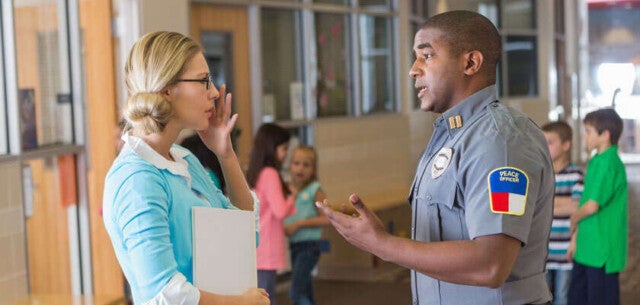Crisis Communication Planning for Heads of Schools

In times of crisis, families and students look to school leaders for stability, even when those schools are closed due to disaster or tragedy. The recent fires and flooding that have torn through communities across the country are a sad reminder that it may not be a question of if a crisis will occur at some point, but when it will happen. Schools regularly review safety practices and hold drills for fire, evacuation, shelter in place, and other vital actions that may be required when tragedy strikes. But there’s one crisis area that isn’t regularly practiced: communication.
While just about every school has an emergency manual, rarely do they contain information about how the school will communicate both internally and externally during a crisis. Fortunately, heads of school can play a vital role in ensuring that a proper crisis communication plan is in place. By partnering with the marketing and communications office and addressing these steps in advance, your school can be better prepared to communicate both internally and externally when needed.
Know your crisis communications response team.
Most likely, there’s a plan for who is responsible for attending to the students and sweeping the classrooms, but there isn’t often a plan in place for communicating during a crisis. In addition to the captains responsible for student safety, there should also be positions determined in advance for communicating with students, families, and the greater community. Each school should designate a team of the top five people called for in every situation, including someone for communication.
Most people immediately think of media relations, and while yes, it’s important to know who will field media questions, crisis communication goes beyond that to include documenting the situation and determining the messaging that is sent out to the community. This role is often called the recorder, and every emergency plan should list the names and contact information for all approved recorders.
A complete and thorough documentation of the process during a crisis can be useful when recapping and reviewing the situation, working with insurance companies and authorities, and determining the messages that need to be conveyed to the school community and beyond. Having one person designated as the recorder—with a backup recorder also pre-determined—means other members of your crisis response team and faculty know who to call and turn to at a moment’s notice.
In addition to a recorder, many schools look to have backup support for sending information out quickly; these people are part of your crisis communication response team. From email and social media to website and parent portal updates, it’s important that you know who has access and the ability to make these updates—including contact information—should a crisis occur outside of normal school hours.
This team also needs to know how to communicate with each other and where they can meet, assuming it is safe. Group chat options are important for ensuring everyone is on the same page, be it via conference calls or walkie-talkies. It’s also important to determine a meeting place if the lines of communication are down, which should be stocked with necessary supplies they may need.
Set a protocol for communicating.
Typically, people assume that the head of school is the spokesperson during a crisis, but the reality is that the head will be dealing with the actual situation and will need help. Having a pre-planned chain of team members who can be spokespeople—ideally members of your crisis communication response team—allows for flexibility and consistency of message. Every member should be familiar with outreach methods, messaging tone and language, and able to log into all communication services—make sure to test these in advance.
Prepare your messaging in advance.
Every school should assess its most-likely crisis scenarios. Fire, shelter in place, and evacuation are common examples, but it’s important to figure out what else could happen and what you would need to communicate. Many schools have added active shooter and intruder drills as well as less obvious situations, such as unexpected school closures, delays, and early dismissals.
Weather and acts of nature may not feel like major crises, but recent events have proven they can be. Schools need to have a plan in place to address these situations quickly and often at odd hours of the day. Extreme heat, snow, lightning, storms, high winds, and even poor air quality are all crisis situations that likely should be on your list, as well as earthquakes, tornadoes, fires, and floods.
Predetermined and scripted messages give you time to think during a crisis. Having messages pre-approved by the head of school, the board, and the communications department allows you to inform people of the situation and prepare them for how you’re going to send follow-up information without wasting time.
These communications should always include the name of the school and the date and time of the message. Families with children at different schools need to know exactly who is calling and how they can get more information. Ending every scripted message with the same line for how to get more information via a URL, parent portal, or phone hotline will give them a way to check in.
Determine the tools you may need.
Knowing the situations you may potentially face lets you draft a plan for each, including the necessary tools. When your internet and phones go down unexpectedly minutes before the dismissal rush, what are you going to do? Planning for something like this in advance will enable you to get a message out quickly.
The established crisis headquarters should be stocked with multiple phone lines, hard wired internet and wifi, several laptops, iPads, cell phones, and walkie talkies to ensure that you can reach the outside world. A radio and television with local and cable news networks can help you track developments of an off-campus crisis that may relate to you and determine if networks are covering your campus crisis situation.
Don’t forget to have ample charging stations with power strips for powering multiple devices at once as well as backup energy sources. Extra batteries and external chargers—including a crank charger—can be useful when power is compromised, as well as dongles and cords for connecting devices to those power sources. You’ll also want to plan what to do if networks go out—so landlines, paper, and pencil supplies should also be handy—as well as flashlights in case you’re in the dark.
Know where and when you’ll communicate.
Communicating a clear and consistent message across dozens of channels can be a challenge, so streamlining your efforts is crucial. It’s a good idea to create a crisis communications landing page that serves as your main hub for posting information, reducing the risk of missing an outlet or posting incorrect or incomplete information in one location. Your team can share a unique URL such as myschool.org/emergency on social media and your other outlets and direct all traffic to this hub.
Not every situation needs immediate text messages and emails, so it’s important to determine what is warranted and when. Less urgent situations—a school cancellation with ample notice, for example—might warrant an email and website update only, whereas an unexpected closure or early dismissal requires phone calls and text messages to ensure that families and the community receive information quickly.
It’s also important to determine outreach frequency. A fast-moving situation that involves the authorities might warrant website updates on your crisis hub page every 15–30 minutes and communication via email and/or phone and text every 1–2 hours. A slow-developing situation such as a broken water main might need an initial message warning of potential closures the day before, a quick update on your website hub several hours later, and then nothing until the next morning when communicating a final decision.
You can also use your emergency outreach services to track the success of your message and determine if some families need more personal outreach to ensure they received the information.
Have a continuity plan.
Ensure you have a plan if the school may be closed for an extended period—such as during a healthcare crisis or when facilities are damaged or destroyed. Determine how you will continue communicating with families, faculty, and staff and how to educate your students remotely. Many schools had to scramble during the COVID-19 pandemic to provide distance learning, some more successfully than others. While nobody wants to return to those days, it’s a good idea to be prepared by practicing digital assignments and assessments, online class discussions, etc. If you are a Blackbaud customer, these resources may be helpful.
Set expectations within your community.
The best way to ensure proper communication is to prepare your community. Let them know that you have an emergency response process and test it more than once. Share the URL of your crisis hub landing page and encourage families to bookmark it. In addition, inform families of your plan during a shelter-in-place scenario, where students will go when evacuating the campus, and how they can reunite with their children in each case.
If families know what to do, where to get information, and how you’re going to communicate, they will feel more confident during a crisis and will be less inclined to inundate the school’s phone lines.
While no one can truly anticipate every need during a crisis, planning for proper communication both internally and externally can make all the difference.
This blog was originally published in 2021 and updated in 2025.


